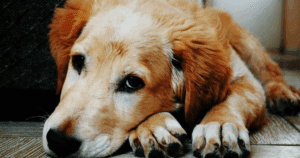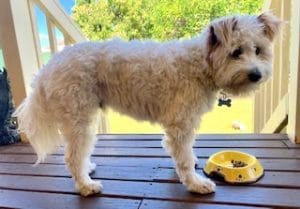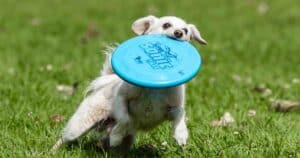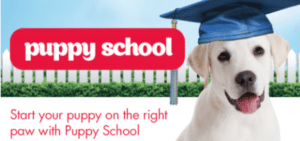If you have a blind dog, or your dog is starting to lose its vision, there are many things you can do to help them and you to adjust to their life in the dark.
Dogs can go blind for many reasons. From cataracts in old age to glaucoma, Progressive Retinal Atrophy (PRA), accidents or other diseases that may see them progressively lose vision.
The list of possible causes is long, but many causes may be treatable if a dog is taken to see a Veterinary Opthamologist as soon as any irregularities are noticed.
One of the key things to look out for is if your dog increasingly starts bumping into things, or they start to lose their orientation, especially at night time in the early stages of vision impairment. These could also be signs of dementia, so it is imperative you take your dog for a check up with your Vet as soon as you notice any changes.
Whatever the circumstances, living with a blind dog doesn’t have to be as daunting as it sounds…for either of you.
In fact, a blind dog can actually adjust quite quickly to life in the dark. Especially, if you tap into their most dominant sense – smell, followed closely by hearing; and begin the training as soon as they begin to lose or have lost their vision.
By following the tips below, a blind dog can be fully adjusted in up to 3 months, particularly if you do start early before they have lost it completely.
1. SAFETY
Get down to their level & dog proof your yard
- Get down on all fours and crawl around your home looking for hazards.
- Put corner protectors on sharp furniture and baby gates at the tops of stairs until your dog can safely manoeuvre them.
- Check for any low branches or other obstacles in the back yard, placing bark a foot around trees, bushes or large objects to help signal an obstacle.
- Fence off the pool or any hazardous areas.
Stairs & slippery floors
- If you have slippery areas, cover with rugs and if any stairs are slippery (see Tip 3)
- Use strips on the stair treads as they learn to navigate.
- As your dog makes progress, you may want to use treats to help guide him or her to navigate the stairs.
- Place a treat on each stair and stand in front of your dog, do not pull them, allowing the treat to be the incentive to find their way as they make their way up and down.
Keep floors clear
- Keep the floor clean of toys, shoes, clothes etc. as they become tripping hazards, particularly the areas they most frequent.
- It’s important to keep toys and shoes off the ground with any dogs and especially those that love to chew. Find out more about why dogs chew and tips to help here.
Make a safe zone
- Have a comfortable, safe spot for your pet to be.
- A large soft-padded bed is helpful to keep them comfortable. Tips on how to choose the right bed for our dog can be found here.
2. USE THEIR SENSE OF SMELL
Use Essentials Oils to mark locations
- Use different dog safe pure essential oils in different rooms to help guide them, but not too many that overwhelms them, ie: 2-3 drops of pure Vanilla in the kitchen, Lavender in the bedroom, Jasmine in the lounge room etc. Make sure you know what essential oils may be harmful to dogs, cats or any other pets in your home before selecting.
- Scent the spot in these rooms that will help them distinguish important areas and items they will need to find such as their dog bed or sleeping area, next to the door that leads to the backyard, the water bowl etc.
- Reapply every couple of weeks.
Scented pot plants & directional smells
- Use scented flower-pots in the backyard, placed in strategic locations ie: near patio, doggy door, or back door. Again, make sure you know what plants are toxic to different pets.
- Make sure you go back to basic toilet training to help direct them to where you want them to go if you have had to change it for any reason due to hazards getting in the way.
3. MAPPING / GUIDING
- Use textured rugs / Location Cues to map out the house
- Use a carpet runner on well-travelled parts of the home. They can feel the floor and use it to correct their course if they got lost.
- Place rugs or floor mats of different textures near the outside doors and at the top and bottom of the steps. This will help your dog learn these locations.
Walk Him Through The House
- Leashing the dog and walking him around will help him familiarise and navigate through the house.
- Use a body harness and tight lead and keep him next to you so you can control and direct his movements.
Don’t Change The Floor Plan
- Once you have arranged the furniture in a way so your dog can easily pass through a room, try not to move it around again.
- Keeping everything in place will help prevent disorientation and injury.
- Push chairs back in after getting up.
Food and water bowls
- Always keep food and water bowls in the same spot or try a drinking fountain-style dog bowl that constantly circulates water and bubbles so they can hear it.
4. SOUND
Locating the back door
- Placing a wind chime or bell near the entrance to the back door of the house will help your dog with orientation.
Talk to Your Dog
- As dogs normally watch our every move, talk to your dog more than ever and ensure you have his attention before touching him so you don’t scare or startle him.
Introduce New Commands
- Teach your dog important safety words like “step up (use high pitch),” “step down (low pitch),” “left,” “right,” “danger” or “stop” to help him safely navigate the inside and outside world.
- Notify your dog as he or she heads towards a wall, using words like “watch, stop, careful.”
Use Bells
- You can attach small bells to your shoes, around your wrist or other pets that can act as a guide to help your dog and so they can hear you moving about the house, at least until he is more familiar with listening to the sounds of footsteps and vibrations from movement.
When leaving your dog alone
- When leaving your dog unattended, a limited space may initially work best.
- Keeping ambient noise like a TV or radio on while you’re gone not only orients your dog to different rooms of the house, but also reduces feelings of loneliness.
5. PLAY
Toys with noise and scent
- It’s important to still engage in active play with your dog. Again use smell and sound to help them.
- Rub a dog treat or put a small drop of essential oil on a dog toy before throwing it to help your pooch find it and choose an open, safe area for him to play in.
- Toys that give treats, squeak, talk or make noise are especially rewarding to blind dogs. They can still work the food out of them. Get the right size for your dog.
6. OUT WALKING
Keep a Routine
- Having a daily routine is very helpful.
- Go to the same parks and on the same walking routes.
Let Others Know
- Get a shirt, bandana or vest for your dog that reads “I’m blind” and tell people about your dog’s condition so they approach slowly and let the dog sniff them first.
- Also, get a tag for your dog’s collar that says “I’m blind” in case she ever gets lost.
7. OTHER TIPS
- Signal to your dog when other people or dogs are approaching with a verbal cue, “dog coming” or “person coming” calm and relaxed tone and keep practising and repeating it so they can learn.
- They should be highly supervised around children so they aren’t startled or feel threatened and bite.
- The key to all dog training is to be clear, consistent and concise which is even more important than ever when helping a blind dog adjust.
- If you aren’t sure how to do this it is important to engage an experienced dog trainer.
About the Author: Lara Shannon is a certified dog behaviourist and trainer, pet food nutrition specialist, Executive Producer and Host of Pooches at Play on Channel 10 and editor of Poochesatplay.com. Lara also runs her own dog training business in Melbourne’s Bayside area and is the Author of World of Dogs and Eat, Play, Love Your Dog







